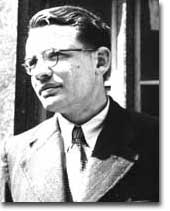Introduction
![]() Hendrik
Brugt Gerhard Casimir (1909-2000)
Hendrik
Brugt Gerhard Casimir (1909-2000)

![]() "On
the attraction between two perfectly conducting plates," H.B.G.
Casimir, Proc. K. Ned. Akad. Wet. 51,
793 (1948)
"On
the attraction between two perfectly conducting plates," H.B.G.
Casimir, Proc. K. Ned. Akad. Wet. 51,
793 (1948)
Normal modes of the Electromagnetic (EM) field between (ideal metal) plates:

Quantum fluctuations of these modes, lead to a zero point energy: (see, e.g. Casimir effect)

This leads to a finite attractive force between plates,

![]() "The
Theory of Molecular Attractive Forces Between Solids," E.M.
Lifshitz, Soviet Physics 2,
73 (1956)
"The
Theory of Molecular Attractive Forces Between Solids," E.M.
Lifshitz, Soviet Physics 2,
73 (1956)
Lifshitz theory generalizes to parallel plates of arbitrary (frequency dependent) dielectrics
Experimental Verification
![]() Early experiments
provided at best qualitative support for an attractive force:
Early experiments
provided at best qualitative support for an attractive force:
M.J. Sparnaay, Physica 24, 751 (1958). [Aluminum plates at distances H>1µm]
Abrikosova & Deriagin, Sov. Phys. JETP 4, 1957 (1957). [Silica lenses]
van Blokland & Overbeek, J. Chem. Soc. F-T. I 74, 2637 (1978). [H 1-100 nm]
![]() The era of
high precision tests, started with S. K. Lamoreaux
The era of
high precision tests, started with S. K. Lamoreaux 
"Demonstration of the Casimir Force in the 0.6 to 6µm Range," (using a torsion pendulum)
U. Mohideen (and collaborators at UC Riverside), using atomic force microscopy
"Precision Measurements of the Casimir Force from 0.1 to 0.9mm,"
T. Ederth (geometry of crossed cylinders)
"Template-stripped gold surfaces ... Casimir force in the 20–100-nm range,"
H. B. Chan, V. A. Aksyuk, R. N. Kleiman, D. J. Bishop, Federico Capasso,
"Quantum Mechanical Actuation of Microelectromechanical Systems by the Casimir Force,"
G. Bressi, G. Carugno, R. Onofrio, and G. Ruoso,
"Measurement of the Casimir Force between Parallel Metallic Surfaces,"
R.S. Decca, D. Lopez, E. Fischbach, and D.E. Krause, Phys. Rev. Lett. 91, 050402 (2003)
"Measurement of the Casimir Force between dissimilar metals,"
Applications
F. Michael Serry, Dirk Walliser, and G. Jordan Maclay,
"The role of the casimir effect in the static deflection and stiction of membrane strips in microelectromechanical systems (MEMS),"
J. Appl. Phys. 84, 2501 (1998)
E. Buks and M. L. Roukes,
"Stiction, adhesion energy, and the Casimir effect in micromechanical systems,"
Phys. Rev. B 63, 033402 (2001)
H. B. Chan, V. A. Aksyuk, R. N. Kleiman, D. J. Bishop, Federico Capasso,
"Quantum Mechanical Actuation of Microelectromechanical Systems by the Casimir Force,"
G. Palasantzas and J. Th. M. De Hosson,
"Pull-in characteristics of electromechanical switches in the presence of Casimir forces: Influence of self-affine surface roughness,"
![]() Challenges
to high percision tests come from:
Challenges
to high percision tests come from:
Geometry: non-planar shapes, roughness, ...
Material: non-ideal metals, impurities, ...
Environment: finite temperatures, gas particles, ...